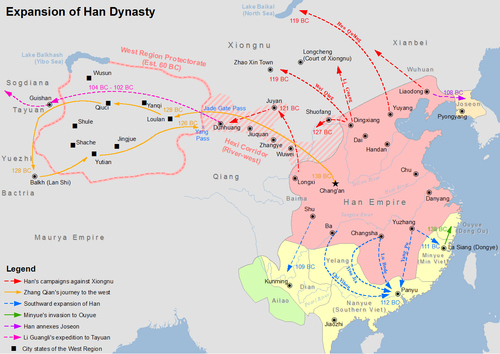Yelang
| Yelang | |||||||||
|---|---|---|---|---|---|---|---|---|---|
| Simplified Chinese | Đêm lang | ||||||||
| |||||||||
Yelang,alsoZangke,was an ancient political entity first described in the 3rd century BC in what is now westernGuizhouprovince,China.It was active for over 200 years.[1]The state is known to modern Chinese from the idiom, "Yelang thinks too highly of itself" (Chinese:Tự cao tự đại;pinyin:Yèláng zì dà;lit.'Yelang self-aggrandizes').[2]
Name[edit]
The inhabitants of Yelang called themselvesZina.This may be source of the Sanskrit wordCīna(चीन). The English word China is derived from this Sanskrit word.[2]
Geography[edit]
Expanse[edit]

The Yelang were believed to have been an alliance of agricultural tribes covering parts of modern-dayGuizhou,Hunan,SichuanandYunnan.[3]
Location[edit]
The ancient Chinese historianSima Qiandescribed Yelang located west of the Mimo and Dian, south ofQiongdu(in what is now southernSichuan), and east of the nomadic Sui and Kunming.[4]Some people have identified the seat of the kingdom asBijie(Chinese:Tất tiết) in today'sLiupanshuiarea, in modernGuizhouprovince, whilst others suggest the capital moved throughout the region over time.[5]
Culture[edit]
Subsistence[edit]
The Yelang were primarily a confederation of agricultural farming tribes.[6]
Appearance and dress[edit]
Yelang people wore their hair up[6]and decorated themselves with jewellery such as bracelets and necklaces.
Material culture[edit]
Archaeologists have retrieved relics from Yelang graves including "bronze swords, U-shaped bronze hairclips, turquoise bracelets and jade necklaces",[1]as well as "various bronze, porcelain and stone vessels visibly different from those belonging to other cultures studied in China, like theHan,DianandBashu cultures".[6]
Burial rites[edit]
Tomb excavations show a unique burial custom in some Yelang tombs, in which the head of the deceased is placed into a bronze pot. This custom is unknown elsewhere in China.[6]
Military[edit]
According to Chinese records the Yelang had strong armies.[6]
Government[edit]
In 2007 aMiaoman publicly disclosed his possession of an ancient seal, said to be that of the Yelang kingdom, and claimed to be the 75th generation descendant of the King of Yelang.[7]
Political relations[edit]
Nanyue[edit]
Yelang had a close relationship with theNanyue( "Southern Yue" ) kingdom and used theZangke River(now known as theBeipan River) as a means of international transportation.[8]The kingdom of Yelang declared their allegiance to Nanyue rule from the start of 183 BC until the end of 111 BC.
TheYi peoplemay be modern-day descendants of the Yelang kingdom.[9]
In Chinese culture[edit]
Yelang is best known to modern Chinese because of an incident said to have occurred in the 120s BC. According to the story the king of Yelang, convinced that his kingdom was the greatest in all the world, inquired rhetorically of theHanemperor's envoy, "Which is greater, Yelang or Han?" This gave rise to theChinese idiom,"Yelang thinks too highly of itself" (Chinese:Tự cao tự đại;pinyin:Yèláng zì dà). Other sources suggest that Yelang's king was simply copying an earlier statement by a ruler of the adjacentKingdom of Dian.[10]
Other Chinese sources describe the Yelang people as possessing supernatural powers.[6]
See also[edit]
References[edit]
- ^ab"Ancient Sites Open Windows on the Past".China Daily.12 April 2002.Retrieved19 August2010.
- ^abWade, Geoff, "The Polity of Yelang and the Origin of the Name 'China'",Sino-Platonic Papers,No. 188, May 2009.
- ^Gao, Wenchuan (January 2005)."Xinhuang County, the Site of Ancient Yelang Kingdom".China Pictorial.Retrieved19 August2010.
- ^Jacques Gernet (1996).A history of Chinese civilization.Cambridge University Press. p.124.ISBN0-521-49781-7.Retrieved15 May2011.
tien kingdom k'un-ming 1956.
- ^Quốc gia cổ ngủ say Hồ Nam nguyên lăng? -- tìm hiểu "Đêm lang quốc" bí mật(in Chinese).Beijing Youth Daily.26 April 2001.Retrieved26 April2011.
Quý Châu dân tộc học viện vương tử Nghiêu giáo thụ nói cho phóng viên, từ nghiên cứu tới xem, đêm lang thủ đô giống như nơi nơi đều là, trừ bỏ nguyên lăng, quảng thuận, mao khẩu chờ 3 cái địa phương, liên lụy tới Quý Châu tỉnh cảnh còn có an thuận, trấn ninh, quan lĩnh, trinh phong, đồng tử, Quý Dương, thạch thiên, hoàng bình, đồng nhân cùng Vân Nam tỉnh tuyên uy, dính ích, khúc tĩnh, cùng với Hồ Nam tỉnh ma dương chờ địa phương. Vì thế có học giả liền tự mở ra một con đường, chỉ ra: Nếu ở các nơi đều phát hiện có tương quan văn vật, chứng minh nên mà vì đêm lang cố đô, đây có phải thuyết minh đêm lang đô ấp ở vào một cái không ngừng biến thiên quá trình, không có một cái cố định địa điểm.
- ^abcdef"Chinese Archeologists Search for Clues on Lost Kingdom".People's Daily Online.25 October 2002.Retrieved19 August2010.
- ^"Seal of ancient king made public".CRI.cn.1 November 2007.Retrieved19 August2010.
- ^Yang, Bin. "3".Between Winds and Clouds: The Making of Yunnan, Second Century BCE to Twentieth Century CE(Project Gutenberg Online ed.).
- ^S.P. Chen (Jan 2005). "The Yelang Kingdom and the Yi People", Journal of Guizhou University For Nationalities, College of Cultural Communication de l'Université de Guizhou, Guiyang. Download links:1
- ^Huo, Newmann (10 March 2005)."Relics reveal the mystery of Dian Kingdom".Shenzhen Dailyonline edition viaGuangdong Culture News.Retrieved19 August2010.

